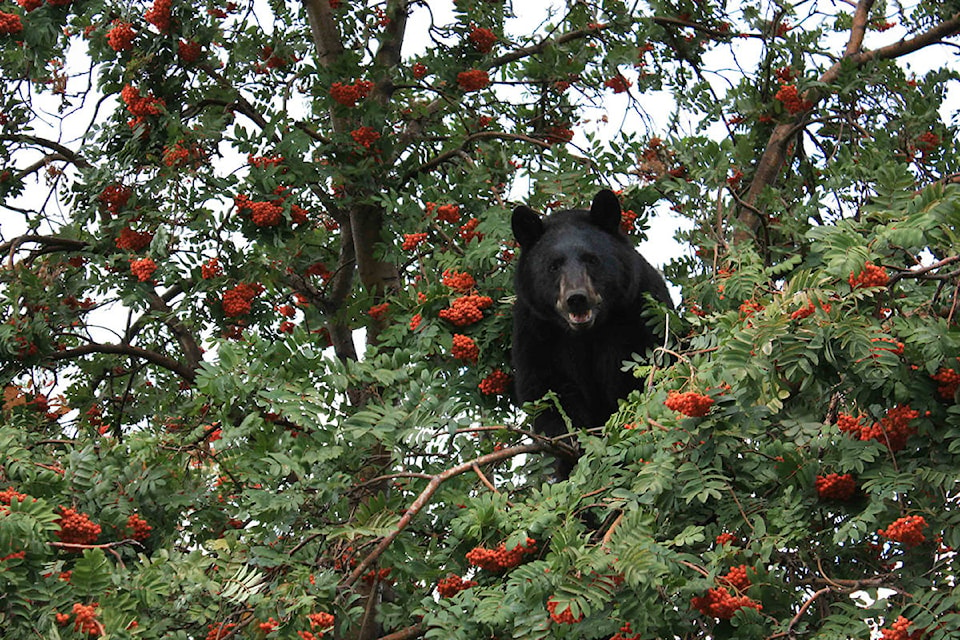It’s that time of year when the Creston Valley’s abundant fruit trees are producing their crops. Cherries, plums, apples and pears are in abundance and, for a short period of time, this creates a massive attractant for bears and rats.
People understand that garbage, for most of the year, is the main attractant that brings bears close to people. This can lead to food-conditioned and habituated bears. While wild bears tend to avoid humans, habituated bears have become accustomed to people and have lost their natural fear, while food-conditioned bears actively seek out human-sourced food. When the initial attractant is no longer available, they will seek other food close to people and may cause property damage or even venture into people’s homes. If a bear is surprised or is protective of a food source this can create an unsafe situation for people and the bears. Bears that are a risk to the public are often destroyed as relocation rarely works. Bears are strongly motivated to return to known food sources.
Many people accept or even enjoy bears feeding in their fruit trees. Unfortunately, fruit trees close to people’s homes have the same impact as garbage on bears. Bears end up destroyed regardless of the attractant. Close to 500 black bears and 40 grizzly bears are destroyed in B.C. every year, most as a result of being food-conditioned. Ensuring all attractants are secure is the only way to break this cycle.
Managing fruit trees can be tricky, especially when trees become mature and they grow to unmanageable sizes. WildSafeBC recommends the following best practices to manage fruit trees:
• Keep fruit trees pruned and manageable so that they are easy to pick
• Power wash blossoms off the trees in the spring to reduce the harvest
• Pick fruit before it is fully ripe and let it ripen indoors in a secure location
• Install an electric fence, either temporary or permanent, to exclude predators
• Consider replacing fruit trees with non-fruit or nut-producing options if you are no longer interested in the fruit
• Work with local fruit-gleaning programs to feed humans not bears
There are some tools that make reaching fruit safer and more convenient, such as using a catcher basket on a pole, made by a number of manufacturers. You can also fabricate your own using empty pop bottles and a pole. There are also ways of managing the amount of fruit on a tree, should you enjoy the tree, but not the fruit. In the spring, as soon as the flowers form, you can use a pressure sprayer to blast away the petals on the flowers before the pollinators arrive, preventing the fruit from forming.
A properly installed electric fence has been shown to be a very effective tool in preventing bears and other wildlife such as raccoons from accessing your fruit tree. There is an electric fence cost-sharing program in the Kootenays for residents in grizzly bear habitat. Contact grizzlybearsolutions@gmail.com for more information on this program.
The Creston Valley Food Action Coalition has a harvest share program whereby volunteers will come harvest unwanted fruit. This program is dependant on volunteer availability and if the fruit is usable. For information on this program visit www.crestonfoodaction.ca.
Bears are an iconic species that play a vital ecological role and are important seed dispersers that rival birds and other animals in many parts of the province. Huckleberries, saskatoons, blackberries, blueberries, raspberries as well as many more plants are all species distributed by bears. When bears are destroyed as a result of our reluctance to manage our attractants, we lose not only that animal but the role that animal plays in the environment.
Unlike bears, Norway and roof rats are not native to this area. Like bears though they will also feast on unpicked fruit. Harvesting fruit will help to manage the rat population by taking away an abundant food source and removing an attractant that could bring these unwanted visitors closer to your residence. So whether it be to reduce human-bear conflict or to prevent rats from feasting, managing our fruit trees is a good idea.
If you are experiencing a conflict with wildlife call the Conservation Officer Service, RAPP line at 1-877-952-7277.
Like us on Facebook and follow us on Twitter
